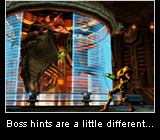This interview originally appeared in Nintendo Dream vol. 85 (March 2003), but was republished on the official Metroid Prime & Fusion website in their interview section in collaboration with Nintendo Dream. These interviews have never been translated until now, and are available exclusively at the Metroid Database!
| — | Are there differences between the American version and the Japanese version? |
| Tanabe | Prime has changed considerably. When making the American version, there were things we’d given up on so we could finish in time for release date, and we improved those parts with the Japanese version. |
| — | Oh? |
| Tanabe |  Because they are small things, they’re not something you would normally notice. For example, although there is information for beating bosses, and there are hints that come up saying “Go here” while you are playing, there are fewer hints in the Japanese version. However, in the American version, we were more worried about people having trouble moving forward. That is, we wanted it to be easier for players to understand where to go, and although it was even requested from the American marketing head, wasn’t Metroid originally a game about wandering aimlessly? However, when we made the Japanese version, since there were too many hints and it wasn’t interesting, we intentionally removed them. Because they are small things, they’re not something you would normally notice. For example, although there is information for beating bosses, and there are hints that come up saying “Go here” while you are playing, there are fewer hints in the Japanese version. However, in the American version, we were more worried about people having trouble moving forward. That is, we wanted it to be easier for players to understand where to go, and although it was even requested from the American marketing head, wasn’t Metroid originally a game about wandering aimlessly? However, when we made the Japanese version, since there were too many hints and it wasn’t interesting, we intentionally removed them. |
| Yamamoto | The Cube version also has the series’ feeling of thoroughly searching the walls. |
| Tanabe | In addition, the enemy difficulty is more severe and the rate of item drops is lower. |
| Yamamoto [sic.] | That’s an unusual pattern. |
| Yamamoto | Regarding the soundtrack, English narration has been added to the opening. Beyond that, I also made changes to one of the boss battle themes [“VS. Flaahgra”] and the BGM before the ending [“Temple Collapse ~ Epilogue”]. |
| — | With Fusion, were parts changed from the American version? |
| Sakamoto | With the American version of Fusion, you can’t select difficulty settings. With the Japanese version, you can select between “easy” and “normal”, and “hard” becomes available once you clear “normal”. And there’s a message inside the game where we allow you to play at various [literacy] levels from adults to little kids by selecting between “Adult Mode” and “Child Mode”. [This turns on or off kanji, making it easier for kids to read -ed.] |
| — | That was really nice of you to include a mode for children! For example, after the words scroll out, text could be written (speaking like a computer) in parentheses. (Laughs) |
| Sakamoto | Like, “Vaccine (A type of medicine).” (Laughs) |
| — | Reading that, it should be helpful when Nintendo Dream writes the article. (Laughs) |
| Sakamoto | That way, supposing a small child was to play it, it’s possible for them to change the difficulty setting. Moreover, after clearing “Child Mode”, they will have a different reward than “Adult Mode”. With Metroid, although it’s conventional for Samus to change her outfit depending on your clear time, with Fusion, you are rewarded with a screen print [lit. “poster screen”] where Samus has changed her outfit. Six screen prints have been added that were not in the American version. And after you clear “Child Mode”, screen prints depicting Samus’ childhood and present-day Samus together will come up. |
| — | Well, what happens when you clear “Adult Mode”? |
| Sakamoto | It’s the same as the overseas version. However, there are a few things I added. [Two bonus gallery images. -ed] Also, I had the Mario Club play it, and those guys are incredible! (Laughs) There opinion was “Wouldn’t it be great if we could pick up lots of items, then clear it faster, and clear with just one energy tank, huh?” And we added that. So altogether, we put in 13 endings. |
| — | So from what you said, that means it’s ok for adults to play “Child Mode”. |
| Sakamoto | That’s right. I had also intended to write the text clearly, and it’s actually a bit funny, it’s fine to let them play it. |
| — | As for Prime, how many endings are there? |
| Tanabe | There are three of them. They don’t relate to clear time, but rather percentage of items, and up to 74% is the Normal ending. Get more than 75%, and you can see Samus’ face in the end. Well, after that, you do 100%, and…that’s a secret. (Laughs) |
| — | Just a little hint! (Laughs) |
| Tanabe | The truth is, we put in an approximately 30-second movie related to “next time”. |
| — | Next time is a sequel to Prime. There’s story after that. (Laughs) |
| Tanabe | Right. (Laughs) |



